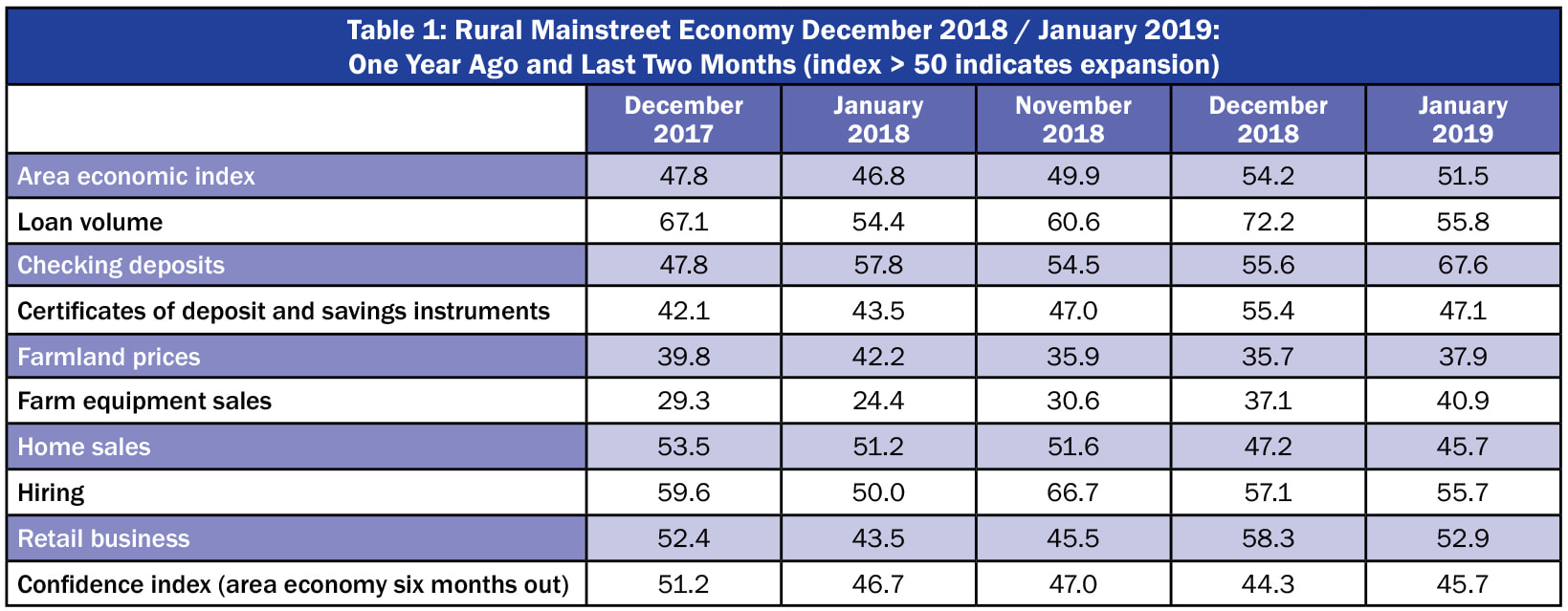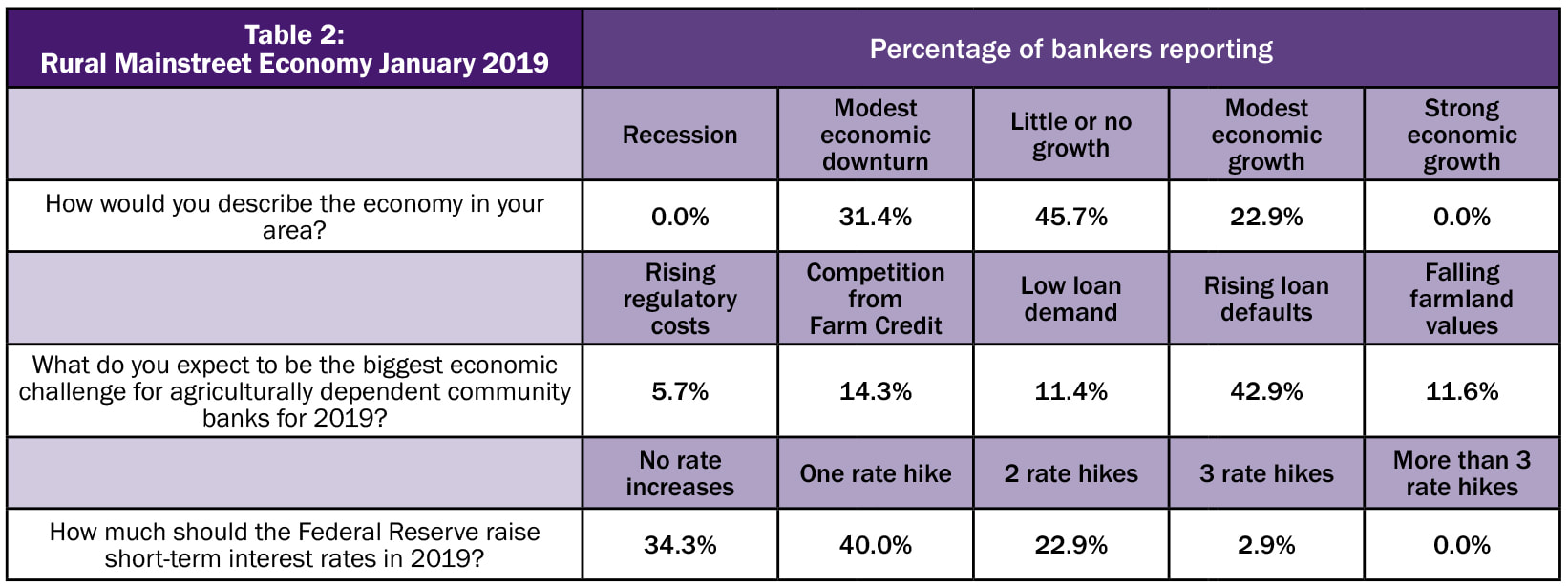- Overall index moves above growth neutral for the 11th time in past 12 months.
- More than four of 10 bank CEOs expect farm loan defaults to be biggest 2019 challenge.
- More than one third of bankers support the Federal Reserve holding on 2019 rate hikes.
- Only 22.9 percent, or slightly more than one in five, bankers reported expanding economic conditions in their area.
Overall: The overall index sank to 51.5 from December’s 54.2. This was the 11th time in the past 12 months the index has remained above growth neutral. The index ranges between 0 and 100 with 50.0 representing growth neutral.
“Our surveys over the last several months indicate the Rural Mainstreet economy is expanding outside of agriculture. However, the negative impacts of tariffs and low agriculture commodity prices continue to weaken the farm sector,” said Ernie Goss, PhD, Jack A. MacAllister Chair in Regional Economics at Creighton University’s Heider College of Business.
The January farm equipment-sales index climbed to 40.9 from December’s 37.1. This marks the 65th consecutive month that the reading has remained below growth neutral 50.0.
Banking: Borrowing by farmers for January was strong as the borrowing index declined to 55.8 from December’s 72.2. The checking-deposit index expanded to 67.6 from December’s 55.6 while the index for certificates of deposit and other savings instruments sank to 47.1 from 55.6 in December.
Hiring: The employment gauge fell to a still solid 55.7 from December’s 57.1. The Rural Mainstreet economy is now experiencing healthy job growth. Over the past 12 months, the Rural Mainstreet economy added jobs at a 0.9 percent pace compared to a higher 1.4 percent for urban areas of the same 10 states.
Confidence: The confidence index, which reflects bank CEO expectations for the economy six months out, climbed to a still anemic 45.7 from December’s 44.3, indicating a pessimistic economic outlook among bankers.
“Tariffs, trade tensions, weak agriculture commodity prices and the partial federal government shutdown negatively influenced the economic outlook of bank CEOs,” said Goss.
Home and Retail Sales: The home-sales index decreased to 45.7 from 47.2 in December. Retail sales sank to 52.9 from December’s stronger 58.3.
This survey represents an early snapshot of the economy of rural agriculturally and energy-dependent portions of the nation. The Rural Mainstreet Index (RMI) is a unique index covering 10 regional states, focusing on approximately 200 rural communities with an average population of 1,300. It gives the most current real-time analysis of the rural economy. Goss and Bill McQuillan, former chairman of the Independent Community Banks of America, created the monthly economic survey in 2005.
| Colorado: Colorado’s Rural Mainstreet Index for January declined to 51.6 from 53.9 in December. The farmland and ranchland-price index rose to 38.1 from December’s 35.7. Colorado’s hiring index for January climbed to 56.2 from December’s 55.7. Over the past 12 months, Colorado’s Rural Mainstreet economy added jobs at a 1.2 percent pace, while urban areas in the state increased jobs by 2.6 percent. Illinois: The January RMI for Illinois fell to 52.2 from 54.9 in December. The farmland-price index climbed to 38.3 from December’s 36.2. The state’s new-hiring index declined to 58.5 from last month’s 59.9. Illinois’ Rural Mainstreet economy added jobs at a 1.5 percent pace, while urban areas in the state increased jobs by 0.9 percent. Iowa: The January RMI for Iowa rose to 54.2 from December’s 53.7. Iowa’s farmland-price index increased to 37.8 from December’s 35.6. Iowa’s new-hiring index for January sank to 53.4 from 54.8 in January. Over the past 12 months, Iowa’s Rural Mainstreet economy added jobs at a 0.5 percent pace, while urban areas in the state increased jobs by 1.6 percent. Kansas: The Kansas RMI for January declined to 51.9 from December’s 54.6. The state’s farmland-price index inched upward to 38.2 from 36.0 in December. The new-hiring index for Kansas decreased to 57.3 from 58.5 in December. Over the past 12 months, Kansas’s Rural Mainstreet economy added jobs at a 1.4 percent pace, while urban areas in the state increased jobs by an identical 1.4 percent. Minnesota: The January RMI for Minnesota dipped to 50.1 from December’s 52.8. Minnesota’s farmland-price index improved to a still weak 37.5 from 35.3 in December. The new-hiring index for January slipped to 50.2 from December’s 51.4. Over the past 12 months, Minnesota’s Rural Mainstreet economy lost jobs at a pace of minus 0.6 percent, while urban areas in the state increased jobs by 1.6 percent. | Missouri: The January RMI for Missouri sank to 53.5 from 56.7 in December. The farmland-price index for the state increased to 38.9 from December’s 36.8. Missouri’s new-hiring index for January plummeted to 55.8 from December’s 66.9. Over the past 12 months, Missouri’s Rural Mainstreet economy added jobs at a 5.2 percent pace, while urban areas in the state increased jobs by 0.9 percent. Nebraska: The Nebraska RMI for January sank to 50.9 from December’s 53.7. The state’s farmland-price index rose to 47.8 from last month’s 35.7. Nebraska’s new-hiring index fell to 53.4 from December’s 54.9. Over the past 12 months, Nebraska’s Rural Mainstreet economy added jobs at a 0.2 percent pace, while urban areas in the state increased jobs by 1.8 percent. North Dakota: The North Dakota RMI for January fell to 51.8 from December’s 54.5. The state’s farmland-price index increased to 38.2 from 37.9 in December. The state’s new-hiring index declined to 57.0 from 58.3 in December. Over the past 12 months, North Dakota’s Rural Mainstreet economy added jobs at a 2.0 percent pace, while urban areas in the state increased jobs by 0.7 percent. South Dakota: The January RMI for South Dakota remained above growth neutral and increased to 55.0 from December’ 54.9. The state’s farmland-price index fell to 34.5 from December’s 37.1. South Dakota’s new-hiring index fell to 58.2 from 59.7 in December. Over the past 12 months, South Dakota’s Rural Mainstreet economy added jobs at a 1.5 percent pace, while urban areas in the state increased jobs by 2.5 percent. Wyoming: The January RMI for Wyoming declined to 53.4 from December’s 56.1. The January farmland and ranchland-price index increased to 38.8 from 36.6 in December. Wyoming’s new-hiring index fell to 63.5 from 64.7 in December. Over the past 12 months, Wyoming’s Rural Mainstreet economy added jobs at a 3.3 percent pace, while urban areas in the state increased jobs by 1.1 percent. |



 RSS Feed
RSS Feed